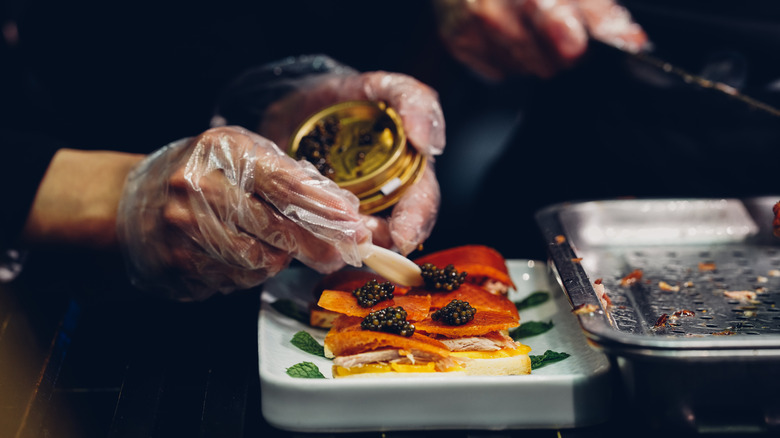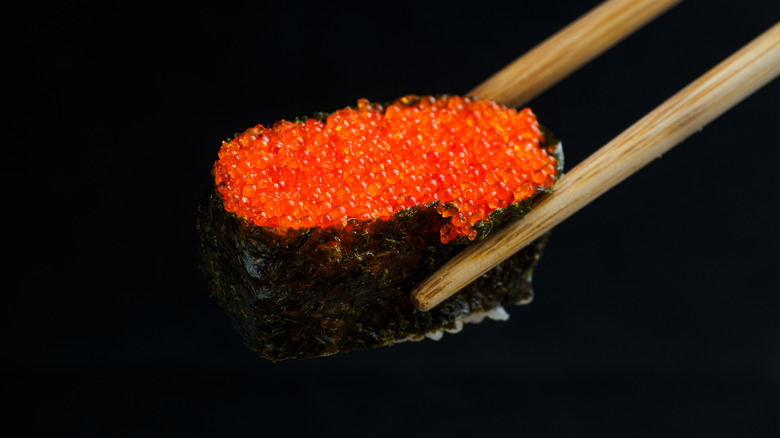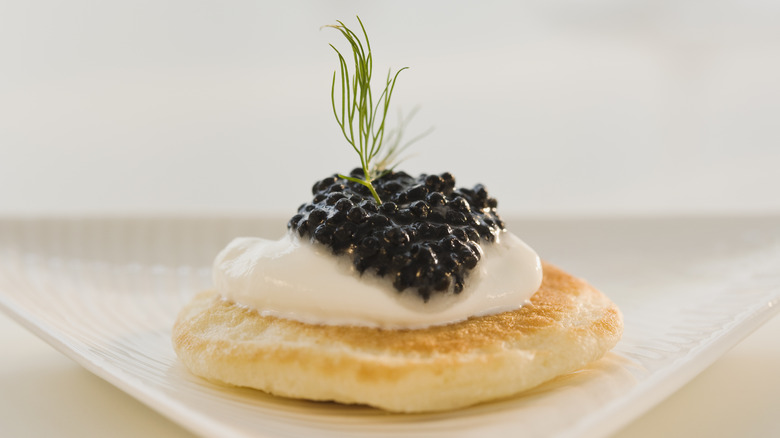Tobiko Vs Caviar: Is There A Difference Between The Fish Eggs?
Yes, the ocean produces actual pearls, but to foodies the real pearls from the nautical world are fish roe. Because fish eggs, or roe, are widely coveted and enjoyed in a variety of dishes, it's important to understand the intricacies and qualities of the various types. Between tobiko and caviar — two of the most common types of roe — the biggest difference is the fish that produce them.
Tobiko — known for its bright orange color and crunchy texture — comes from flying fish, most commonly Japanese flying fish. After harvesting, tobiko is cured with salt and takes on a smoky, salty flavor, in addition to a striking orange color. Caviar, on the other hand, are the salt-cured eggs of sturgeon. There are many fish that are in the sturgeon family, but all are fairly rare. This fish's relative scarcity often leads to high caviar prices. Typically, caviar is black in color, briny and buttery in taste, and smooth and velvety in texture. To understand more, let's get into the (sea)weeds of the differences between tobiko and caviar.
Tobiko is often found on top of sushi
Tobiko is sushi's favorite jewelry, as it often glistens atop rolls such as a nori-wrapped piece of maki. Tobiko's crunchy nature acts as a contrast to the delicate textures of white rice and raw fish, while its smoky and salty flavor enhances the nuances of seafood.
Though bright orange is the standard look of tobiko, it can be infused with different flavors and then dyed with to reflect those elements. For example, wasabi-infused tobiko can be bright green, while tobiko that's taken on a black color has probably been dyed with savory, briny squid ink. In addition to topping sushi, tobiko can introduce smoky, umami flavors to a variety of dishes that welcome a savory foundation, such as pasta.
For anyone who's curious about tobiko but not interested in eating animal products, IKEA has been known to sell a vegan version made from seaweed (including a black-dyed variety that more closely resembles caviar). However, you may not find it in your local store, as availability reportedly varies by location.
Caviar ain't your average roe
As caviar has grown in popularity, other types of roe — such as tobiko — have begun to fall under its title. However, because of its rich intrigue and exclusivity, it's important to understand what sets genuine caviar apart from other types of fish eggs.
Caviar are unfertilized eggs that have been harvested from sturgeon fish. Sturgeon, including the rare beluga and kaluga types, are a rare species of fish. This means that caviar's harvesting and curing process ought to be done with extreme care. The eggs are subsequently cured in salt and packaged in air-tight containers. Though caviar is almost always of utmost quality, its color and flavor depends on the type of fish and quality of the eggs. Most caviar is black with hints of green or gold. It packs rich and briny flavor in the pearls, as well as a smooth texture.
The eggs tend to come in miniature containers, as small amounts of caviar demand high prices. It is most commonly presented as a topping, whether it's on a rich risotto or toast with a dash of crème fraiche. Though it's traditionally paired with high-brow ingredients, some have tested the limits of caviar, from pairing it with Doritos to topping a hot dog.


